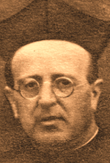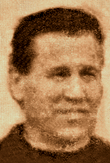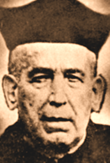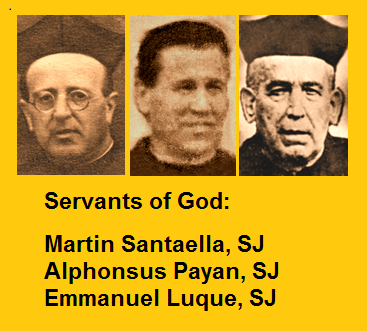Jesuits Servants of God
Martin Santaella,SJ: Born : February 3, 1873. Died: August 27, 1936
Alphonsus Payan,SJ : Born: February 20, 1877. Died: August 31, 1936
Emmanuel Luque, SJ : Born: December 28, 1856. Died: August 31, 1936
 Martin Santaella Gutierrez was born in Montefrio, in the province of Granada. He studied at the diocesan seminary and after his ordination, he was appointed pastor at Algarinejo. At the age of forty-four years old he chose to become a Jesuit and began his noviceship in Granada on June 28, 1917. After his two-year probation he spent one year in private study and in 1920, he was assigned to give parish missions in Andalusia where he remained for the next fifteen years. He travelled throughout Andalusia preaching to the people and was remembered by them as being an affable and compassionate priest, especially toward the poor and needy. He only gave up his role as an itinerant preacher in 1935 when he was sixty-two to become the vice-superior at the Jesuit residence in Almeria.
Martin Santaella Gutierrez was born in Montefrio, in the province of Granada. He studied at the diocesan seminary and after his ordination, he was appointed pastor at Algarinejo. At the age of forty-four years old he chose to become a Jesuit and began his noviceship in Granada on June 28, 1917. After his two-year probation he spent one year in private study and in 1920, he was assigned to give parish missions in Andalusia where he remained for the next fifteen years. He travelled throughout Andalusia preaching to the people and was remembered by them as being an affable and compassionate priest, especially toward the poor and needy. He only gave up his role as an itinerant preacher in 1935 when he was sixty-two to become the vice-superior at the Jesuit residence in Almeria.
When Spain’s civil war broke out in July 1936, Fr Santaella refused to go into hiding for his own personal safety and continued his ministry as best he could at the apartment. He was soon arrested on July 23, 1936 and after interrogation he was detained in various prisons until he was finally taken to the ship Astoy-Mendi, a floating prison in the Almeria harbor. Despite the very poor ventilation and sanitary conditions in the over crowded hold, Fr Santaella went about attending to the prisoners to encourage them and to hear their confessions who were periodically taken out of the hold to be executed.
On August 27, a soldier came into the hold and began to choose some of the prisoners to go to work in the coal bunkers of the Jaime 1, a warship anchored in the harbour. Fr Santaella thought it was a good time to go and visit a sick priest in another part of the hold despite his Jesuit companions’ plea not to do so and was spotted by the soldier and included in the coal bunkers work. Work on board the Jaime 1 was very onerous. They were paired off with one of the men in charge of the bunkers and they have to shovel coal from one side to the other without any purpose. If they relaxed in their effort, the guard would strike them with a rubber rod on their head and shoulders. The bunkers would have a small air opening leading to the outside and the vents would be open as long as the guards were there. Then the vents would be closed and the chute openings in the bunkers’ roofs were then opened and in poured coal dust in such great amounts that the prisoners could not see anything even though the electric lights were on. After fifteen minutes of breathing in the noisome dust, the prisoners were ordered out the exits by following the sound of the guards’ voices and were immediately cudgeled and taken on deck. Fr Santaella was sixty-three and had to be given artificial respiration but never revived. It was believed that the guards threw his body into one of the ship’s furnaces and he never left Jaime 1.
 Fr Alphonsus Payan Perez was born at Gines, in the province of Seville. He entered the Granada novitiate on November 6, 1895 and studied philosophy at Granada and theology at Murcia. He then taught at the Jesuit schools in Chamartin and Villafranca before he took up residence at the Jesuit parish in Granada where he known to be an outstanding preacher with a special ability to communicate the truths of the faith in a way easily understood by the faithful. Fr Payan was arrested twice before the civil war broke out for speaking out against the dictatorship but released because the charges were never proven. When the civil war broke out, he chose to remain in the residence with the eightieth old Fr Luque although he was offered a hiding place and it was there that they were arrested.
Fr Alphonsus Payan Perez was born at Gines, in the province of Seville. He entered the Granada novitiate on November 6, 1895 and studied philosophy at Granada and theology at Murcia. He then taught at the Jesuit schools in Chamartin and Villafranca before he took up residence at the Jesuit parish in Granada where he known to be an outstanding preacher with a special ability to communicate the truths of the faith in a way easily understood by the faithful. Fr Payan was arrested twice before the civil war broke out for speaking out against the dictatorship but released because the charges were never proven. When the civil war broke out, he chose to remain in the residence with the eightieth old Fr Luque although he was offered a hiding place and it was there that they were arrested.
 Fr Emmanuel Luque Fontanilla was born in Marchena, in the province of Seville. He entered the Society at Murcia on September 11, 1856 and after his studies at Ona, he went to teach Spanish history and geography at Villafranca until 1896 when he became spiritual father at the seminary in Granada. In 1906 he moved to Murcia, where he was made superior, and then in 1909 went to work in the Jesuit parish in Granada before going to Almeria in 1913 to continue in his pastoral ministry. He stayed in Almeria for twenty-three years during which time he gained a great following among the people who loved him for his concern for the poor. He was loved by the clergy, including the bishop who made him their confessor. When hostility broke out in Almeria, Fr Luque thought it was useless to seek refuge as he was waiting to return home to God. He thus placidly remained at the Jesuit residence until his arrest at the end of July 1936.
Fr Emmanuel Luque Fontanilla was born in Marchena, in the province of Seville. He entered the Society at Murcia on September 11, 1856 and after his studies at Ona, he went to teach Spanish history and geography at Villafranca until 1896 when he became spiritual father at the seminary in Granada. In 1906 he moved to Murcia, where he was made superior, and then in 1909 went to work in the Jesuit parish in Granada before going to Almeria in 1913 to continue in his pastoral ministry. He stayed in Almeria for twenty-three years during which time he gained a great following among the people who loved him for his concern for the poor. He was loved by the clergy, including the bishop who made him their confessor. When hostility broke out in Almeria, Fr Luque thought it was useless to seek refuge as he was waiting to return home to God. He thus placidly remained at the Jesuit residence until his arrest at the end of July 1936.
 After Frs Luque and Payan were arrested they were held for several days in a convent which was turned into a prison. On August 27, 1936 they were taken to Astoy-Mendi in the harbour together with two bishop, thirty-eight priests and fifty lay peoples. They were notified on the night of August 31 that some were to be transferred to a prison in the city which they interpreted that these were to be executed. Among those whose names were called were Frs Luque and Payan. When Fr Luque’s name was called out, one of the prisoners remarked: “If Fr Luque is not safe here, then none of us are.” Even some of the communist soldiers were surprised that the old priest had been picked as everyone in America knew he was politically harmless.
After Frs Luque and Payan were arrested they were held for several days in a convent which was turned into a prison. On August 27, 1936 they were taken to Astoy-Mendi in the harbour together with two bishop, thirty-eight priests and fifty lay peoples. They were notified on the night of August 31 that some were to be transferred to a prison in the city which they interpreted that these were to be executed. Among those whose names were called were Frs Luque and Payan. When Fr Luque’s name was called out, one of the prisoners remarked: “If Fr Luque is not safe here, then none of us are.” Even some of the communist soldiers were surprised that the old priest had been picked as everyone in America knew he was politically harmless.
The bodies of Frs Luque and Payan were discovered in 1941, together with the others, in a deep abandoned well at Taberna, outside the city and taken to Almeria and interred in the Jesuit church. The diocesan investigation process into the martyrdom of Frs Martin Santaella, Emmanuel Luque and Alphonsus Payan was opened in Almeria on January 18, 1956
